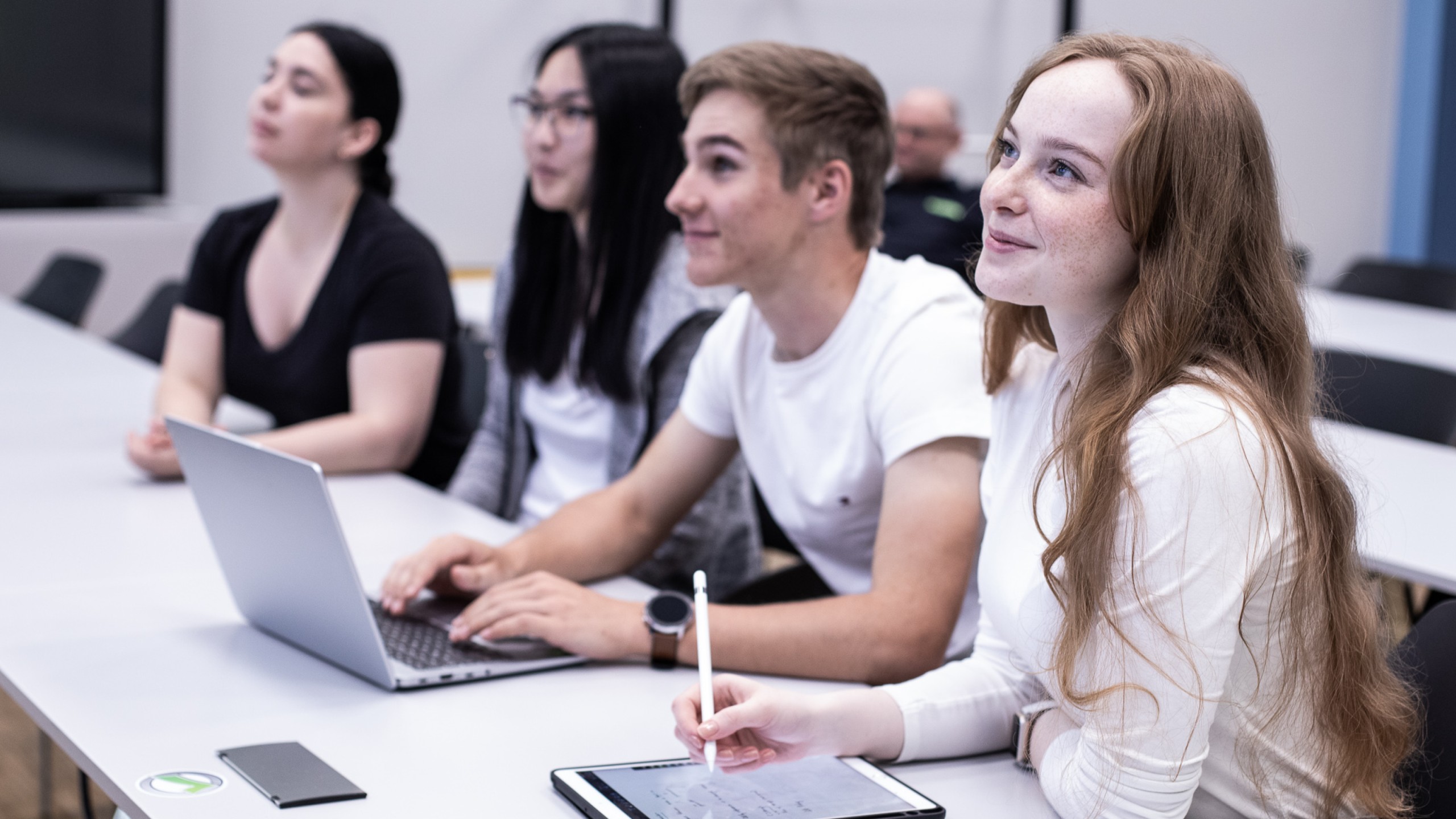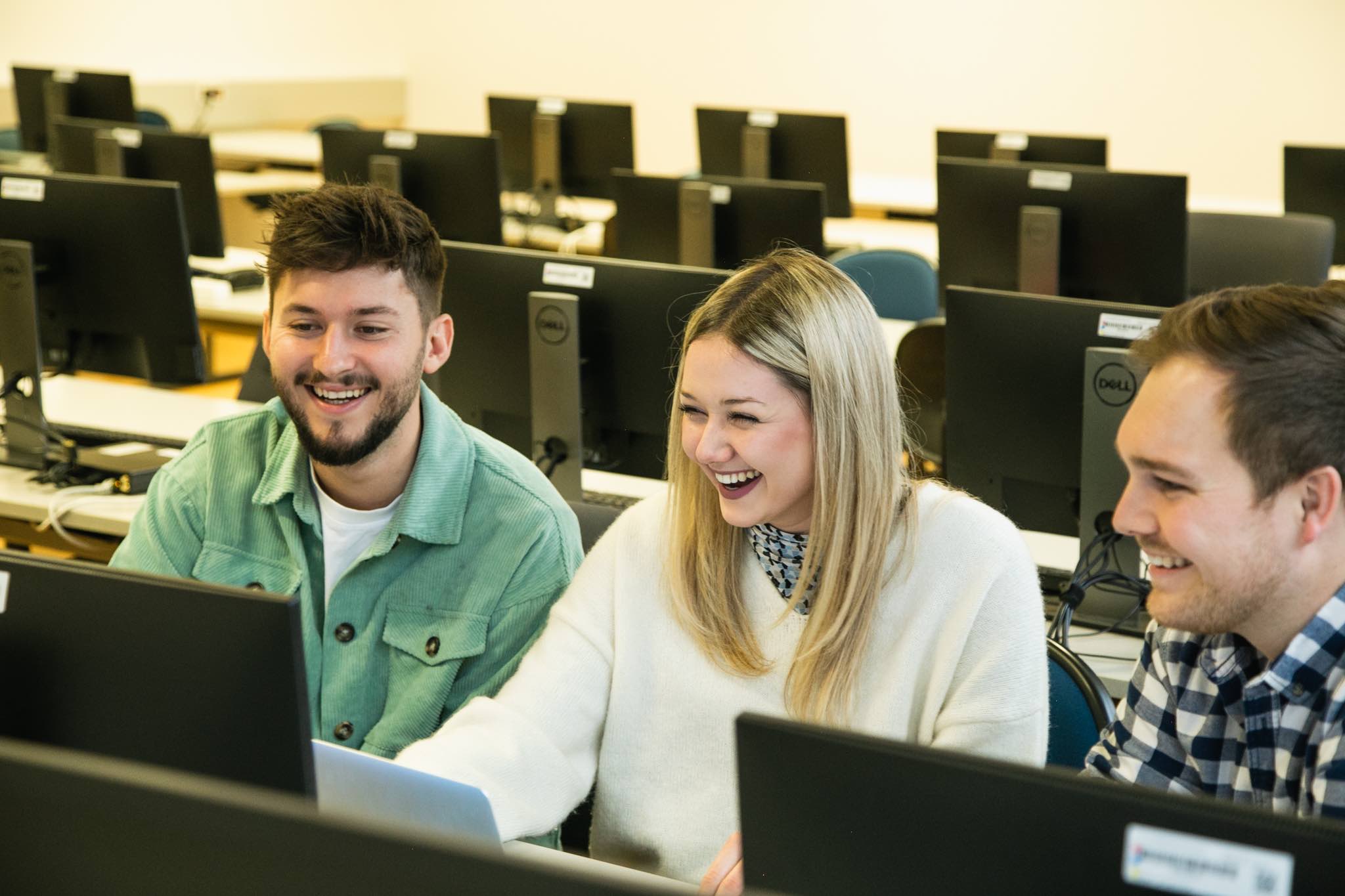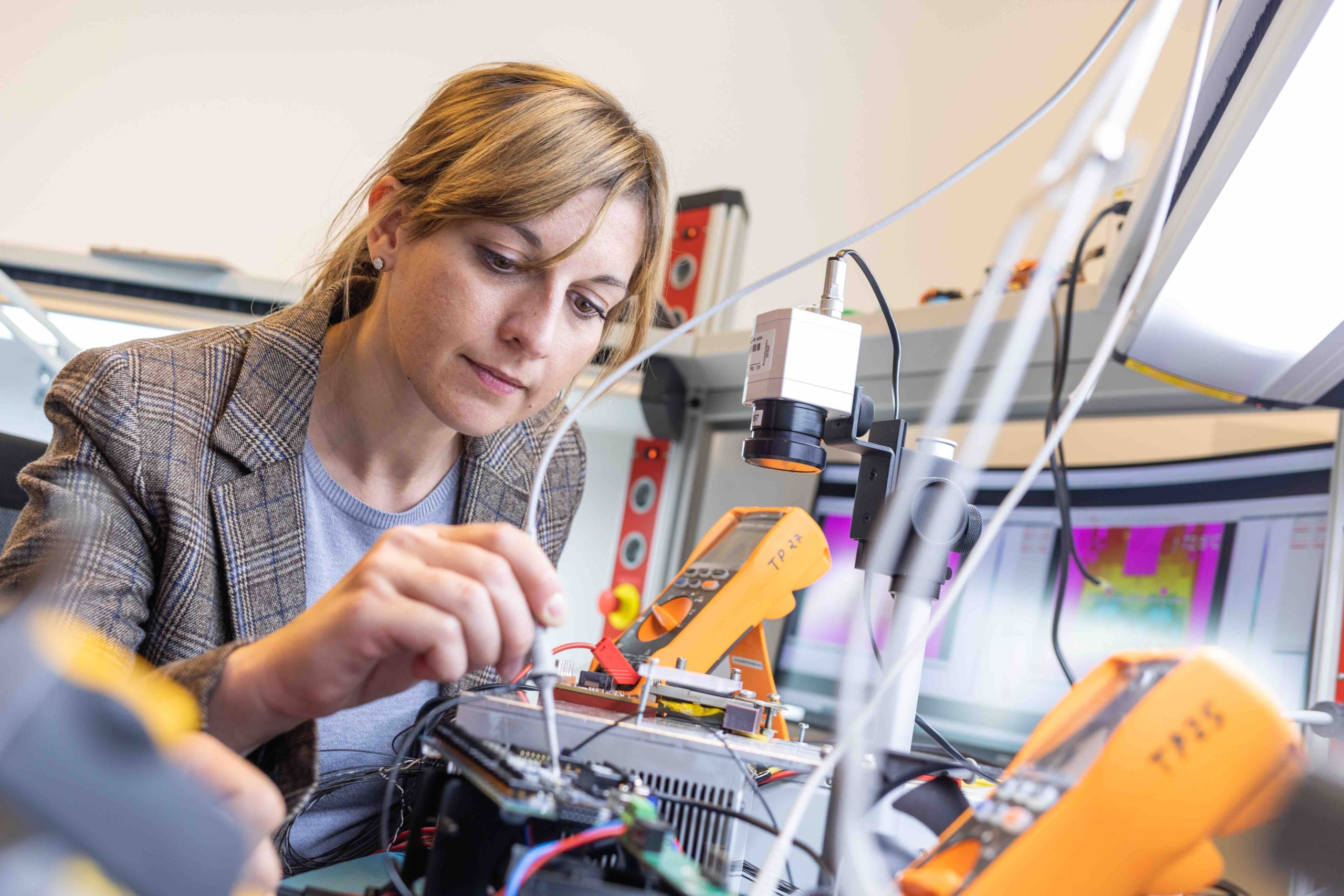
Ready, study, go!
Top informiert ins Studium starten.

Study your dream!
Alle Infos zum Studieren.

Stay in touch!
Mit der Hochschule verbunden bleiben.

Study with Purpose!
Unser vielfältiges Studienangebot entdecken.

Educate with Purpose!
Weiterbilden, weiterdenken, weiterkommen.

Research with Purpose!
Forschen von der Idee zur Anwendung.

Stay up to date!
Das Online-Magazin der FH JOANNEUM.

Better together!
Als Zukunftshochschule eröffnen wir neue Lebenswelten.
DI Dr.
Sten Hanke
Funktion
Assoziierter Professor (FH)
Telefon
Adresse
FH JOANNEUM
eHealth
Eckertstraße, 30i
Raum ES30i.01.117
8020 Graz
Österreich
eHealth
Eckertstraße, 30i
Raum ES30i.01.117
8020 Graz
Österreich
Steckbrief
All publications
Peer-Reviewed Journal Publications
[1] Sten Hanke et al. “Utilization of an EOG based controlling device with Body Area Network connectivity”. In: Biomedizinische Technik Supplementary Vol 56, Part 1 (2005), pp. 1495–1496. issn: 0939-4990.
[2] Marius Mikalsen et al. “Interoperability Services in the MPOWER Ambient Assisted Living Platform”. In: Medical Informatics in a United and Healthy Europe - Studies in Health Technology and Informatics 150 (2009), pp. 366–370.
[3] Werner Reichenfelser et al. “Influence of FES cycling on spasticity in subjects with incomplete spastic paraplegia”. In: Rehabilitation: Mobility, Exercise and Sports - Assistive Technology Research Series 26 (2010),
pp. 317–319.
[4] Georg Dorffner et al. “Empirical evidence for robust parameters separating electroencephalograms from awake and sleep-deprived subjects”. In: JOURNAL OF SLEEP RESEARCH. Vol. 21.WILEY-BLACKWELL 111 RIVER ST, HOBOKEN 07030-5774, NJ USA. 2012, pp. 323–323.
[5] Gregor Koenig et al. “Empirical evidence for circadian and homeostatic trends in electroencephalogram-derived vigilance parameters”. In: JOURNAL OF SLEEP RESEARCH. Vol. 21.WILEY-BLACKWELL 111 RIVER ST, HOBOKEN 07030-5774, NJ USA. 2012, pp. 36–36.
[6] Sten Hanke et al. “A Wearable Device for Realtime Assessment of Vigilance”. In: Biomedical Engineering / Biomedizinische Technik (2013).
[7] Erlend Stav et al. “Development and evaluation of SOA-based AALservices in real-life environments: A case study and lessons learned”. In: International Journal of Medical Informatics 82.11 (2013), pp. 269–293. issn: 1386-5056.
[8] Ulrich Chiellino et al. “Ablenkung beim Autofahren - eine überschätzte Gefahr?” In: VKU - Verkehrsunfall und Fahrzeugtechnik Vku Vol 7 (2015), pp. 269–277.
[9] Sten Hanke et al. “Reasoning and Data Representation in a Health and Lifestyle Support System.” In: Studies in health technology and informatics, 235 (2017), p. 8.
General Articles & Magazines
[10] Stefan Mina et al. “Multi-parameter Data Acquisition on Interface Devices for the Development of Adaptive Input Systems”. English. In: Computers Helping People with Special Needs. Ed. by Klaus Miesenberger et al. Vol. 3118. Lecture Notes in Computer Science. Springer Berlin Heidelberg, 2004, pp. 37–44. isbn: 978-3-540-22334-4.
[11] Sten Hanke. “universAAL - an example for an innovative project in the AAL field”. In: Elektrotechnik und Informationstechnik. Vol. 1. 2010.
[12] Sten Hanke et al. “universAAL - An Open and Consolidated AAL Platform”. In: Ambient Assisted Living. Ed. by Reiner Wichert and Birgid Eberhardt. Springer Berlin Heidelberg, 2011, pp. 127–140. isbn: 978-3- 642-18166-5.
[13] Sten Hanke. “universAAL - Eine Plattform f¨ur AAL-Services”. In: Das Medizin Produkt, Lösungen für das Gesundheitswesen. Vol. 25. 2012.
[14] Thomas Karopka, Francesco Potorti, and Sten Hanke. “Open Minds”. In: PS public service review. Vol. 31. publicservice.co.uk Ltd, 2012, pp. 1–3.
[15] Mohammad-Reza Tazari et al. “The universAAL Reference Model for AAL”. In: Handbook of Ambient Assisted Living. Ed. by Juan Carlos Augusto et al. Vol. 11. Ambient Intelligence and Smart Environments. IOS Press, 2012, pp. 610–625. isbn: 978-1-60750-836-6.
[16] Sten Hanke. “AAL Austria–Innovationsplattform f¨ur intelligente Assistenz im Alltag”. In: Lebensqualit¨at im Wandel von Demografie und Technik (2013).
[17] Sten Hanke et al. “CogniWin - A Virtual Assistance System for Older Adults at Work”. English. In: Human Aspects of IT for the Aged Population. Design for Everyday Life. Ed. by Jia Zhou and Gavriel Salvendy. Vol. 9194. Lecture Notes in Computer Science. Springer International Publishing, 2015, pp. 257–268. isbn: 978-3-319-20912-8.
[18] Sten Hanke et al. “Embodied Ambient Intelligent Systems”. In: Recent Advances in Ambient Assisted Living Bridging Assistive Technologies, e-Health and Personalized Health Care 20 (2015). Ed. by Wei Chen et al., p. 65.
[19] Miroslav Sili et al. “Talking Faces in Lab and Field Trials”. English. In: Human Aspects of IT for the Aged Population. Design for Aging. Ed. by Jia Zhou and Gavriel Salvendy. Vol. 9193. Lecture Notes in Computer Science. Springer International Publishing, 2015, pp. 134–144. isbn: 978-3-319-20891-6.
[20] Deepika Singh et al. “Convolutional and Recurrent Neural Networks for Activity Recognition in Smart Environment”. In: Towards Integrative Machine Learning and Knowledge Extraction. Ed. by Andreas Holzinger et al. Vol. 10344. Lecture Notes in Computer Science. Springer, Cham, 2017,
pp. 194–205. isbn: 978-3-319-69775-8.
[21] Christiana Tsiourti et al. “The CaMeLi Framework—A Multimodal Virtual Companion for Older Adults”. In: Intelligent Systems and Applications: Extended and Selected Results from the SAI Intelligent Systems Conference (IntelliSys) 2016. Ed. by Yaxin Bi, Supriya Kapoor, and Rahul Bhatia. Cham: Springer International Publishing, 2018, pp. 196–217. isbn: 978-3-319-69266-1. doi: 10.1007/978-3-319-69266-1_10.
Conference Proceedings
[22] Sten Hanke and Stefan Mina. “EOG controlled computer systems with Body Area Network connectivity”. In: Proceedings ¨Osterreichische Gesellschaft für Biomedizinsche Technik. Universal Access in Human-Computer Interaction. Vol. 4555. 2004, pp. 769–776.
[23] Stefan Mina and Sten Hanke. “Multimodal, RF based Body Area Network for Device Control”. In: Proceedings of 8th Vienna International Workshop on Functional Electrical Stimulation. 2004, p. 2.
[24] Andreas Oberleitner and Sten Hanke. “An approach to measure and classify physical fitness without active exercise tests”. In: Proceedings of the ¨Osterreichische Gesellschaft f¨ur Biomedizinische Technik (¨OGBMT). 2005.
[25] Sara Brunner et al. “EOG Pattern Recognition Trial for a Human Computer Interface”. In: Proceedings of the 4th International Conference on Universal Access in Human Computer Interaction: Coping with Diversity. UAHCI’07. Beijing, China: Springer-Verlag, 2007, pp. 22–27. isbn: 978-3-540-73278-5.
[26] Erwin Fugger et al. “Requirements and Ethical Issues for Sensor-augmented Environments in Elderly Care”. In: Proceedings of the 4th International Conference on Universal Access in Human Computer Interaction: Coping with Diversity. UAHCI’07. Beijing, China: Springer-Verlag, 2007, pp. 887–893. isbn: 978-3-540-73278-5.
[27] Werner Reichenfelser et al. “FES-Fahrradtrainingsystem f¨ur Paraplegiker”. In: Proceedings Deutschsprachige Medizin Gesellschaft f¨ur Paraplegie (DMGP). 2007.
[28] Sten Hanke and Thomas Fuxreiter. “Interoperability in Smart Home Middleware - TheMPower Project.” In: HEALTHINF (1). Ed. by Luis Azevedo and Ana Rita Londral. INSTICC - Institute for Systems, Technologies of Information, Control, and Communication, Apr. 10, 2008, pp. 176–181. isbn: 978-989-8111-16-6.
[29] Werner Reichenfelser et al. “Trainings- and Measurement- System for FES-Cycling”. In: 13th Annual Conf. of the International Functional Electrical Stimulation Society, Freiburg, Germany; 21.09.2008 - 25.09.2008,
IFESS 2008-from movement to mind, Biomedizinische Technik. Vol. 53. Suppl.1, Berlin, New York, Proceedings, 2008, pp. 265–267.
[30] Sten Hanke et al. “Automated Vigilance Classification based on EOG signals: Preliminary Results”. In: World Congress on Medical Physics and Biomedical Engineering, September 7 - 12, 2009, Munich, Germany. Ed. by Ratko Magjarevic, Olaf D¨ossel, and Wolfgang C. Schlegel. Vol. 25/9. 10.1007/978-3-642-03889-1 115. Springer Berlin Heidelberg, 2009, pp. 428–431. isbn: 978-3-642-03889-1.
[31] Sten Hanke et al. “EOG based vigilance classifcation: Preliminary results”. In: Proceedings of 5th PhD-Symposium of Young Scientist Association of the Medical University of Vienna. 2009.
[32] Johannes Kropf et al. “Different Approaches for middleware platforms and technology integration”. In: European Conference AmI 2009, Salzburg; 18.11.2009 - 21.11.2009, Ambient Intelligence, Lecture Notes in Computer Science. Nov. 2009. isbn: 978-3-642-05407-5.
[33] Christopher Mayer et al. “Flexible and Standard-Compliant Framework for Sensor Based AAL Smart Home Applications”. In: Proceedings of Intelligent Buildings and Smart Homes Conference 2009, Taipei; 18.11.2009 - 20.11.2009. Nov. 2009, pp. 200–203.
[34] Thomas Fuxreiter et al. “A modular platform for event recognition in smart homes”. In: e-Health Networking Applications and Services (Healthcom), 2010 12th IEEE International Conference on. July 2010, pp. 1–6.
[35] Sten Hanke et al. “A Need for an Interoperable Open Source Middleware for Ambient Assisted Living Applications - A Position Paper”. In: HEALTHINF’10. 2010, pp. 517–524.
[36] Sten Hanke et al. “Flexible Sensor Architektur zur Sensordatenanalyse und Mustererkennung im AAL Kontext”. In: Deutscher AAL-Kongress, Berlin, Demographischer Wandel - Assistenzsysteme aus der Forschung in den Markt. 2010. isbn: 978-3-8007-3209-8.
[37] Philipp Nieke et al. “Interoperability in Ambient Assisted Living (AAL) - Standardization of Sensor-data based on ISO/IEEE 11073”. In: HEALTHINF’ 10. 2010, pp. 406–413.
[38] Sten Hanke et al. “A 24-h vigilance profile based on EOG and EEG”. In: Proceedings of 7th PhD-Symposium of Young Scientist Association of the Medical University of Vienna. 2011.
[39] Sten Hanke et al. “universAAL - An Open Platform and Reference Specification for Ambient Assisted Living”. In: International Society for Telemedicine and eHealth (ISfTeH), MedTel (2011), pp. 42–46.
[40] Sten Hanke et al. “universAAL - eine offene und konsolidierte AALPlattform”. In: 4. Deutscher AAL Kongress, Berlin; 25.01.2011 - 26.01.2011, Demographischer Wandel - Assistenzsysteme aus der Forschung in den Markt (2011).
[41] Christopher Mayer et al. “Ambient Assisted Living User Interfaces”. In: Everyday Technology for Independence and Care, AAATE (2011), pp. 456–463.
[42] Christopher Mayer et al. “Das trojanische Pferd oder:Wie Energieeffizienz und Wohnkomfort Technologie in die H¨auser ¨alterer Leute bringen”. In: 4. Deutscher AAL Kongress, Berlin; 25.01.2011 - 26.01.2011, Demographischer
Wandel - Assistenzsysteme aus der Forschung in den Markt (2011).
[43] Sten Hanke et al. “To Build up an Ambient Assisted Living Open Association (AALOA)”. In: AAL Summit 2013 Bilbao - Market and policy development for an aging society conference. 2012.
[44] Sten Hanke et al. “The AALOA exploitation model for AAL project results”. In: Impacting individuals, society and economic growth. Ed. by Erika Pohjanen. Proceedings of the 5th AAL Forum Norrk¨oping, Sweden, Sept. 24, 2013, pp. 335–339. isbn: 978-91-637-6407-3.
[45] Davide Bacciu et al. “Smart environments and context-awareness for lifestyle management in a healthy active ageing framework”. In: Proceedings of the 17th Portuguese Conference on Artificial Intelligence (EPIA 2015). 2015.
[46] Sten Hanke et al. “The Technical Specification and Architecture of a Virtual Support Partner”. In: Proceedings of Workshop and Papers of the European Conference on Ambient Intelligence. AmI, 2015.
[47] David Portugal et al. “CogniWin: An Integrated Framework to Support Older Adults at Work”. In: UMAP. 2016.
[48] Miroslav Sili et al. “Personalization in the User Interaction Design”. In: Proceedings, Part I, of the 18th International Conference on Human-Computer Interaction. Theory, Design, Development and Practice - Volume 9731. New York, NY, USA: Springer-Verlag New York, Inc., 2016, pp. 198–207. isbn: 978-3-319-39509-8.
[49] A. Stainer-Hochgatterer, C. Wings-Kölgen, D. Cereghetti, S. Hanke, E. Sandner Miraculous-life: An avatar-based virtual support partner to assist daily living Gerontechnology 2016; 15(suppl):95s doi: http://dx.doi.org/10.4017/gt.2016.15.s.012.00
[50] Sten Hanke ; Emanuel Sandner ; Samat Kadyrov and Andreas Stainer-Hochgatterer “Daily life support at home through a virtual support partner”. Technologies for Active and Assisted Living (TechAAL 2016), 2nd IET International Conference on, Publisher: IET, Online ISBN: 978-1-78561-393-7, DOI: 10.1049/ic.2016.0058, 24-25 Oct. 2016
[51] Mark Scase et al. “Development of and adherence to a computer-based gamified environment designed to promote health and wellbeing in older people with mild cognitive impairment.” In: Health Informatics Meets EHealth: Digital Insight–Information-Driven Health & Care. Proceedings of the 11th EHealth2017 Conference. Vol. 236. IOS Press. 2017, p. 348.
[52] Deepika Singh et al. “Human Activity Recognition Using Recurrent Neural Networks”. In: International Cross-Domain Conference for Machine Learning and Knowledge Extraction. Springer, Cham. 2017, pp. 267–274.
[53] Deepika Singh et al. “Ambient Assisted Living Technologies from the Perspectives of Older People and Professionals”. In: Machine Learning and Knowledge Extraction: First IFIP TC 5, WG 8.4, 8.9, 12.9 International Cross-Domain Conference, CD-MAKE 2017, Reggio, Italy, August 29 – September 1, 2017, Proceedings. Ed. by Andreas Holzinger et al. Cham: Springer International Publishing, 2017, pp. 255–266. isbn: 978-3-319- 66808-6. doi: 10.1007/978-3-319-66808-6_17.
[54] Enrico Machado et al. "A Conceptual framework for Adaptive User Interfaces for older adults". In: 2018 IEEE International Conference on Pervasive Computing and Communications Workshops (PerCom Workshops). IEEE. 2018
[55] Deepika Singh et al."Users' Perceptions and Attitudes Towards Smart Home Technologies". In: Smart Homes and Health Telematics, Designing a Better Future: Urban Assisted Living. Ed. by Mounir Mokhtari, Bessam Abdulrazak, and Hamdi Aloulou. Cham: Springer International Publish ing, 2018, pp. 203-214. isbn: 978-3-319-94523-1.
[56] J. G. Terius-Padron et al. "Towards Self-management of Chronic Diseases in Smart Homes : Physical Exercise Monitoring for Chronic Obstruction Pulmonary Disease Patients". In: 2018 IEEE International Conference on Pervasive Computing and Communications Workshops (PerCom Workshops) . Mar. 2018, pp. 776-781.
Edited Proceedings
[57] Christiana Tsiourti, Sten Hanke, and Luis Santos, eds. Proc. Workshop on Social Interaction and Multimodal Expression for Socially Intelligent Robots + The Barriers of Social Robotics take-up by Society (WS-SIME + Barriers of Social Robotics, Lisbon, Portugal, August 2017). urn:nbn:de:0074-2059-5. CEUR-WS.org, 2017.
Diploma Thesis
[58] Sten Hanke. “Klassifizierung der Verfahren der Zeitreihen und Frequenzanalyse zur Beurteilung der Cerebralen Autoregulation”. In: Mid Study Thesis Technical University of Dresden, Institute for Biomedical Engineering (2003).
[59] Sten Hanke. “EOG gesteuerte Rechnersysteme mit BodyArea-Network Anbindung”. In: Diploma Thesis Technical University of Dresden, Institute for Biomedical Engineering and ARC Seibersdorf research / biomedical
engineering (2005).
Dissertation
[60] Sten Hanke. “Realtime Assessment of Vigilance based on integrated EOG Biosignal Pattern Recognition”. In: Dissertation Medical University of Vienna (2012).
Professional Experience
Scientific Coordinator Active and Assisted Living Solutions, AIT Austrian Institute of Technology GmbH, Vienna, Austria.
R&D Project Manager, AIT Austrian Institute of Technology GmbH, Vienna, Austria.
R&D Project Manager and Senior Researcher, Universiy of Geneva - Institute of Services Science, Geneva, Switzerland.
R&D Project Development Consultant, Instituto Pedro Nunes IPN, Coimbra, Portugal
Scientific assistant and developer (Hardware), ARC Seibersdorf research GmbH, Vienna, Austria.
Internship, ARC Seibersdorf research GmbH, Vienna, Austria
Internship, Sulzer Metco (US) Inc., Westbury N.Y., U.S.A..
Internship, Mannesmann Dematic AG, Department for Electrical Engineering and Automation Engineering, Wetter, Germany.
Education
Ph.D. / Doctor scientiæ medicæ, Medical University of Vienna – Institute of Biomedical Engineering and Physics , Vienna, Austria.
MSc. / Dipl.-Ing., Technical University of Dresden - Faculty of Electrical and Computer Engineering, Dresden, Germany.
Memberships
Working Member of the Governing Board of Ambient Assisted Living Open Association (AALOA)
Working Member of the Austrian standardization group ÖN238.4 for Medical Device Communication
Working Member of the ISO IEEE 11073 Personal Health Data Working Group
Peer-Reviewed Journal Publications
[1] Sten Hanke et al. “Utilization of an EOG based controlling device with Body Area Network connectivity”. In: Biomedizinische Technik Supplementary Vol 56, Part 1 (2005), pp. 1495–1496. issn: 0939-4990.
[2] Marius Mikalsen et al. “Interoperability Services in the MPOWER Ambient Assisted Living Platform”. In: Medical Informatics in a United and Healthy Europe - Studies in Health Technology and Informatics 150 (2009), pp. 366–370.
[3] Werner Reichenfelser et al. “Influence of FES cycling on spasticity in subjects with incomplete spastic paraplegia”. In: Rehabilitation: Mobility, Exercise and Sports - Assistive Technology Research Series 26 (2010),
pp. 317–319.
[4] Georg Dorffner et al. “Empirical evidence for robust parameters separating electroencephalograms from awake and sleep-deprived subjects”. In: JOURNAL OF SLEEP RESEARCH. Vol. 21.WILEY-BLACKWELL 111 RIVER ST, HOBOKEN 07030-5774, NJ USA. 2012, pp. 323–323.
[5] Gregor Koenig et al. “Empirical evidence for circadian and homeostatic trends in electroencephalogram-derived vigilance parameters”. In: JOURNAL OF SLEEP RESEARCH. Vol. 21.WILEY-BLACKWELL 111 RIVER ST, HOBOKEN 07030-5774, NJ USA. 2012, pp. 36–36.
[6] Sten Hanke et al. “A Wearable Device for Realtime Assessment of Vigilance”. In: Biomedical Engineering / Biomedizinische Technik (2013).
[7] Erlend Stav et al. “Development and evaluation of SOA-based AALservices in real-life environments: A case study and lessons learned”. In: International Journal of Medical Informatics 82.11 (2013), pp. 269–293. issn: 1386-5056.
[8] Ulrich Chiellino et al. “Ablenkung beim Autofahren - eine überschätzte Gefahr?” In: VKU - Verkehrsunfall und Fahrzeugtechnik Vku Vol 7 (2015), pp. 269–277.
[9] Sten Hanke et al. “Reasoning and Data Representation in a Health and Lifestyle Support System.” In: Studies in health technology and informatics, 235 (2017), p. 8.
General Articles & Magazines
[10] Stefan Mina et al. “Multi-parameter Data Acquisition on Interface Devices for the Development of Adaptive Input Systems”. English. In: Computers Helping People with Special Needs. Ed. by Klaus Miesenberger et al. Vol. 3118. Lecture Notes in Computer Science. Springer Berlin Heidelberg, 2004, pp. 37–44. isbn: 978-3-540-22334-4.
[11] Sten Hanke. “universAAL - an example for an innovative project in the AAL field”. In: Elektrotechnik und Informationstechnik. Vol. 1. 2010.
[12] Sten Hanke et al. “universAAL - An Open and Consolidated AAL Platform”. In: Ambient Assisted Living. Ed. by Reiner Wichert and Birgid Eberhardt. Springer Berlin Heidelberg, 2011, pp. 127–140. isbn: 978-3- 642-18166-5.
[13] Sten Hanke. “universAAL - Eine Plattform f¨ur AAL-Services”. In: Das Medizin Produkt, Lösungen für das Gesundheitswesen. Vol. 25. 2012.
[14] Thomas Karopka, Francesco Potorti, and Sten Hanke. “Open Minds”. In: PS public service review. Vol. 31. publicservice.co.uk Ltd, 2012, pp. 1–3.
[15] Mohammad-Reza Tazari et al. “The universAAL Reference Model for AAL”. In: Handbook of Ambient Assisted Living. Ed. by Juan Carlos Augusto et al. Vol. 11. Ambient Intelligence and Smart Environments. IOS Press, 2012, pp. 610–625. isbn: 978-1-60750-836-6.
[16] Sten Hanke. “AAL Austria–Innovationsplattform f¨ur intelligente Assistenz im Alltag”. In: Lebensqualit¨at im Wandel von Demografie und Technik (2013).
[17] Sten Hanke et al. “CogniWin - A Virtual Assistance System for Older Adults at Work”. English. In: Human Aspects of IT for the Aged Population. Design for Everyday Life. Ed. by Jia Zhou and Gavriel Salvendy. Vol. 9194. Lecture Notes in Computer Science. Springer International Publishing, 2015, pp. 257–268. isbn: 978-3-319-20912-8.
[18] Sten Hanke et al. “Embodied Ambient Intelligent Systems”. In: Recent Advances in Ambient Assisted Living Bridging Assistive Technologies, e-Health and Personalized Health Care 20 (2015). Ed. by Wei Chen et al., p. 65.
[19] Miroslav Sili et al. “Talking Faces in Lab and Field Trials”. English. In: Human Aspects of IT for the Aged Population. Design for Aging. Ed. by Jia Zhou and Gavriel Salvendy. Vol. 9193. Lecture Notes in Computer Science. Springer International Publishing, 2015, pp. 134–144. isbn: 978-3-319-20891-6.
[20] Deepika Singh et al. “Convolutional and Recurrent Neural Networks for Activity Recognition in Smart Environment”. In: Towards Integrative Machine Learning and Knowledge Extraction. Ed. by Andreas Holzinger et al. Vol. 10344. Lecture Notes in Computer Science. Springer, Cham, 2017,
pp. 194–205. isbn: 978-3-319-69775-8.
[21] Christiana Tsiourti et al. “The CaMeLi Framework—A Multimodal Virtual Companion for Older Adults”. In: Intelligent Systems and Applications: Extended and Selected Results from the SAI Intelligent Systems Conference (IntelliSys) 2016. Ed. by Yaxin Bi, Supriya Kapoor, and Rahul Bhatia. Cham: Springer International Publishing, 2018, pp. 196–217. isbn: 978-3-319-69266-1. doi: 10.1007/978-3-319-69266-1_10.
Conference Proceedings
[22] Sten Hanke and Stefan Mina. “EOG controlled computer systems with Body Area Network connectivity”. In: Proceedings ¨Osterreichische Gesellschaft für Biomedizinsche Technik. Universal Access in Human-Computer Interaction. Vol. 4555. 2004, pp. 769–776.
[23] Stefan Mina and Sten Hanke. “Multimodal, RF based Body Area Network for Device Control”. In: Proceedings of 8th Vienna International Workshop on Functional Electrical Stimulation. 2004, p. 2.
[24] Andreas Oberleitner and Sten Hanke. “An approach to measure and classify physical fitness without active exercise tests”. In: Proceedings of the ¨Osterreichische Gesellschaft f¨ur Biomedizinische Technik (¨OGBMT). 2005.
[25] Sara Brunner et al. “EOG Pattern Recognition Trial for a Human Computer Interface”. In: Proceedings of the 4th International Conference on Universal Access in Human Computer Interaction: Coping with Diversity. UAHCI’07. Beijing, China: Springer-Verlag, 2007, pp. 22–27. isbn: 978-3-540-73278-5.
[26] Erwin Fugger et al. “Requirements and Ethical Issues for Sensor-augmented Environments in Elderly Care”. In: Proceedings of the 4th International Conference on Universal Access in Human Computer Interaction: Coping with Diversity. UAHCI’07. Beijing, China: Springer-Verlag, 2007, pp. 887–893. isbn: 978-3-540-73278-5.
[27] Werner Reichenfelser et al. “FES-Fahrradtrainingsystem f¨ur Paraplegiker”. In: Proceedings Deutschsprachige Medizin Gesellschaft f¨ur Paraplegie (DMGP). 2007.
[28] Sten Hanke and Thomas Fuxreiter. “Interoperability in Smart Home Middleware - TheMPower Project.” In: HEALTHINF (1). Ed. by Luis Azevedo and Ana Rita Londral. INSTICC - Institute for Systems, Technologies of Information, Control, and Communication, Apr. 10, 2008, pp. 176–181. isbn: 978-989-8111-16-6.
[29] Werner Reichenfelser et al. “Trainings- and Measurement- System for FES-Cycling”. In: 13th Annual Conf. of the International Functional Electrical Stimulation Society, Freiburg, Germany; 21.09.2008 - 25.09.2008,
IFESS 2008-from movement to mind, Biomedizinische Technik. Vol. 53. Suppl.1, Berlin, New York, Proceedings, 2008, pp. 265–267.
[30] Sten Hanke et al. “Automated Vigilance Classification based on EOG signals: Preliminary Results”. In: World Congress on Medical Physics and Biomedical Engineering, September 7 - 12, 2009, Munich, Germany. Ed. by Ratko Magjarevic, Olaf D¨ossel, and Wolfgang C. Schlegel. Vol. 25/9. 10.1007/978-3-642-03889-1 115. Springer Berlin Heidelberg, 2009, pp. 428–431. isbn: 978-3-642-03889-1.
[31] Sten Hanke et al. “EOG based vigilance classifcation: Preliminary results”. In: Proceedings of 5th PhD-Symposium of Young Scientist Association of the Medical University of Vienna. 2009.
[32] Johannes Kropf et al. “Different Approaches for middleware platforms and technology integration”. In: European Conference AmI 2009, Salzburg; 18.11.2009 - 21.11.2009, Ambient Intelligence, Lecture Notes in Computer Science. Nov. 2009. isbn: 978-3-642-05407-5.
[33] Christopher Mayer et al. “Flexible and Standard-Compliant Framework for Sensor Based AAL Smart Home Applications”. In: Proceedings of Intelligent Buildings and Smart Homes Conference 2009, Taipei; 18.11.2009 - 20.11.2009. Nov. 2009, pp. 200–203.
[34] Thomas Fuxreiter et al. “A modular platform for event recognition in smart homes”. In: e-Health Networking Applications and Services (Healthcom), 2010 12th IEEE International Conference on. July 2010, pp. 1–6.
[35] Sten Hanke et al. “A Need for an Interoperable Open Source Middleware for Ambient Assisted Living Applications - A Position Paper”. In: HEALTHINF’10. 2010, pp. 517–524.
[36] Sten Hanke et al. “Flexible Sensor Architektur zur Sensordatenanalyse und Mustererkennung im AAL Kontext”. In: Deutscher AAL-Kongress, Berlin, Demographischer Wandel - Assistenzsysteme aus der Forschung in den Markt. 2010. isbn: 978-3-8007-3209-8.
[37] Philipp Nieke et al. “Interoperability in Ambient Assisted Living (AAL) - Standardization of Sensor-data based on ISO/IEEE 11073”. In: HEALTHINF’ 10. 2010, pp. 406–413.
[38] Sten Hanke et al. “A 24-h vigilance profile based on EOG and EEG”. In: Proceedings of 7th PhD-Symposium of Young Scientist Association of the Medical University of Vienna. 2011.
[39] Sten Hanke et al. “universAAL - An Open Platform and Reference Specification for Ambient Assisted Living”. In: International Society for Telemedicine and eHealth (ISfTeH), MedTel (2011), pp. 42–46.
[40] Sten Hanke et al. “universAAL - eine offene und konsolidierte AALPlattform”. In: 4. Deutscher AAL Kongress, Berlin; 25.01.2011 - 26.01.2011, Demographischer Wandel - Assistenzsysteme aus der Forschung in den Markt (2011).
[41] Christopher Mayer et al. “Ambient Assisted Living User Interfaces”. In: Everyday Technology for Independence and Care, AAATE (2011), pp. 456–463.
[42] Christopher Mayer et al. “Das trojanische Pferd oder:Wie Energieeffizienz und Wohnkomfort Technologie in die H¨auser ¨alterer Leute bringen”. In: 4. Deutscher AAL Kongress, Berlin; 25.01.2011 - 26.01.2011, Demographischer
Wandel - Assistenzsysteme aus der Forschung in den Markt (2011).
[43] Sten Hanke et al. “To Build up an Ambient Assisted Living Open Association (AALOA)”. In: AAL Summit 2013 Bilbao - Market and policy development for an aging society conference. 2012.
[44] Sten Hanke et al. “The AALOA exploitation model for AAL project results”. In: Impacting individuals, society and economic growth. Ed. by Erika Pohjanen. Proceedings of the 5th AAL Forum Norrk¨oping, Sweden, Sept. 24, 2013, pp. 335–339. isbn: 978-91-637-6407-3.
[45] Davide Bacciu et al. “Smart environments and context-awareness for lifestyle management in a healthy active ageing framework”. In: Proceedings of the 17th Portuguese Conference on Artificial Intelligence (EPIA 2015). 2015.
[46] Sten Hanke et al. “The Technical Specification and Architecture of a Virtual Support Partner”. In: Proceedings of Workshop and Papers of the European Conference on Ambient Intelligence. AmI, 2015.
[47] David Portugal et al. “CogniWin: An Integrated Framework to Support Older Adults at Work”. In: UMAP. 2016.
[48] Miroslav Sili et al. “Personalization in the User Interaction Design”. In: Proceedings, Part I, of the 18th International Conference on Human-Computer Interaction. Theory, Design, Development and Practice - Volume 9731. New York, NY, USA: Springer-Verlag New York, Inc., 2016, pp. 198–207. isbn: 978-3-319-39509-8.
[49] A. Stainer-Hochgatterer, C. Wings-Kölgen, D. Cereghetti, S. Hanke, E. Sandner Miraculous-life: An avatar-based virtual support partner to assist daily living Gerontechnology 2016; 15(suppl):95s doi: http://dx.doi.org/10.4017/gt.2016.15.s.012.00
[50] Sten Hanke ; Emanuel Sandner ; Samat Kadyrov and Andreas Stainer-Hochgatterer “Daily life support at home through a virtual support partner”. Technologies for Active and Assisted Living (TechAAL 2016), 2nd IET International Conference on, Publisher: IET, Online ISBN: 978-1-78561-393-7, DOI: 10.1049/ic.2016.0058, 24-25 Oct. 2016
[51] Mark Scase et al. “Development of and adherence to a computer-based gamified environment designed to promote health and wellbeing in older people with mild cognitive impairment.” In: Health Informatics Meets EHealth: Digital Insight–Information-Driven Health & Care. Proceedings of the 11th EHealth2017 Conference. Vol. 236. IOS Press. 2017, p. 348.
[52] Deepika Singh et al. “Human Activity Recognition Using Recurrent Neural Networks”. In: International Cross-Domain Conference for Machine Learning and Knowledge Extraction. Springer, Cham. 2017, pp. 267–274.
[53] Deepika Singh et al. “Ambient Assisted Living Technologies from the Perspectives of Older People and Professionals”. In: Machine Learning and Knowledge Extraction: First IFIP TC 5, WG 8.4, 8.9, 12.9 International Cross-Domain Conference, CD-MAKE 2017, Reggio, Italy, August 29 – September 1, 2017, Proceedings. Ed. by Andreas Holzinger et al. Cham: Springer International Publishing, 2017, pp. 255–266. isbn: 978-3-319- 66808-6. doi: 10.1007/978-3-319-66808-6_17.
[54] Enrico Machado et al. "A Conceptual framework for Adaptive User Interfaces for older adults". In: 2018 IEEE International Conference on Pervasive Computing and Communications Workshops (PerCom Workshops). IEEE. 2018
[55] Deepika Singh et al."Users' Perceptions and Attitudes Towards Smart Home Technologies". In: Smart Homes and Health Telematics, Designing a Better Future: Urban Assisted Living. Ed. by Mounir Mokhtari, Bessam Abdulrazak, and Hamdi Aloulou. Cham: Springer International Publish ing, 2018, pp. 203-214. isbn: 978-3-319-94523-1.
[56] J. G. Terius-Padron et al. "Towards Self-management of Chronic Diseases in Smart Homes : Physical Exercise Monitoring for Chronic Obstruction Pulmonary Disease Patients". In: 2018 IEEE International Conference on Pervasive Computing and Communications Workshops (PerCom Workshops) . Mar. 2018, pp. 776-781.
Edited Proceedings
[57] Christiana Tsiourti, Sten Hanke, and Luis Santos, eds. Proc. Workshop on Social Interaction and Multimodal Expression for Socially Intelligent Robots + The Barriers of Social Robotics take-up by Society (WS-SIME + Barriers of Social Robotics, Lisbon, Portugal, August 2017). urn:nbn:de:0074-2059-5. CEUR-WS.org, 2017.
Diploma Thesis
[58] Sten Hanke. “Klassifizierung der Verfahren der Zeitreihen und Frequenzanalyse zur Beurteilung der Cerebralen Autoregulation”. In: Mid Study Thesis Technical University of Dresden, Institute for Biomedical Engineering (2003).
[59] Sten Hanke. “EOG gesteuerte Rechnersysteme mit BodyArea-Network Anbindung”. In: Diploma Thesis Technical University of Dresden, Institute for Biomedical Engineering and ARC Seibersdorf research / biomedical
engineering (2005).
Dissertation
[60] Sten Hanke. “Realtime Assessment of Vigilance based on integrated EOG Biosignal Pattern Recognition”. In: Dissertation Medical University of Vienna (2012).
Professional Experience
Scientific Coordinator Active and Assisted Living Solutions, AIT Austrian Institute of Technology GmbH, Vienna, Austria.
R&D Project Manager, AIT Austrian Institute of Technology GmbH, Vienna, Austria.
R&D Project Manager and Senior Researcher, Universiy of Geneva - Institute of Services Science, Geneva, Switzerland.
R&D Project Development Consultant, Instituto Pedro Nunes IPN, Coimbra, Portugal
Scientific assistant and developer (Hardware), ARC Seibersdorf research GmbH, Vienna, Austria.
Internship, ARC Seibersdorf research GmbH, Vienna, Austria
Internship, Sulzer Metco (US) Inc., Westbury N.Y., U.S.A..
Internship, Mannesmann Dematic AG, Department for Electrical Engineering and Automation Engineering, Wetter, Germany.
Education
Ph.D. / Doctor scientiæ medicæ, Medical University of Vienna – Institute of Biomedical Engineering and Physics , Vienna, Austria.
MSc. / Dipl.-Ing., Technical University of Dresden - Faculty of Electrical and Computer Engineering, Dresden, Germany.
Memberships
Working Member of the Governing Board of Ambient Assisted Living Open Association (AALOA)
Working Member of the Austrian standardization group ÖN238.4 for Medical Device Communication
Working Member of the ISO IEEE 11073 Personal Health Data Working Group
Lehrveranstaltungen
eHealth (Master, Berufsermöglichend)
Sommersemester | Coursecode: M19.0415401
Masterarbeit
0.00
ECTS1.00
SWS
Sommersemester | Coursecode: M19.0415203
Electronic Health Records
5.00
ECTS3.00
SWS
Sommersemester | Coursecode: M19.0415402
eHealth-Anwendungen (Kolloquium)
5.00
ECTS2.00
SWS
Wintersemester | Coursecode: M19.0415301
Master Project
10.00
ECTS1.00
SWS
Wintersemester | Coursecode: M19.0415304